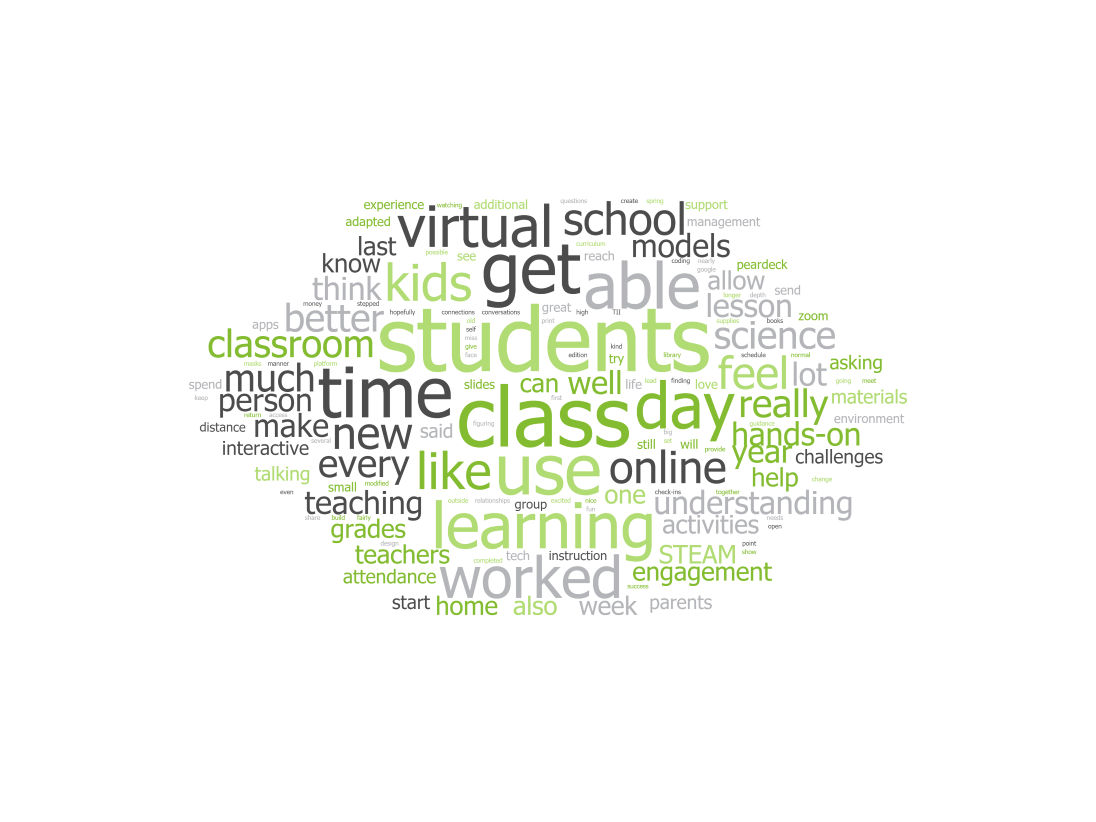Adapting Amid Adversity: Data About STEM Teachers Supporting Self-Direction and Classroom Community in Fall 2020
By Jessica Sickler and Michelle Lentzner
Posted on 2020-12-18
Disclaimer: The views expressed in this blog post are those of the author(s) and do not necessarily reflect the official position of the National Science Teaching Association (NSTA).

At the risk of understating the situation, this school year has been rough. As districts shuffled and re-shuffled plans–virtual, hybrid, in-person–teachers faced this question: How do I maintain my use of self-direction and classroom community–two pillars of STEM sensemaking? It’s been difficult, but our work with 90 amazing STEM teachers from the Teacher Innovator Institute (TII), a National Air & Space Museum (NASM) professional development (PD) program, has shown the ways it can happen.
Our ongoing evaluation work with the TII teachers has confirmed just how difficult the fall semester was. In an October survey of 69 middle school STEAM teachers from across the United States, we found that 40% were still teaching in virtual-only environments, and fewer than 20% were teaching fully in-person; this was before the holiday surge in COVID-19 cases. We found that teachers in rural or mid-country locations were more likely to teach in-person at the start of the year, while no urban teachers were working entirely in-person. Teachers were clear: Times are tough. Constant flux in environment and schedules, taking on new and unexpected roles (such as tech support), and feeling they hadn't enough hours to do everything presented immense challenges to creating the STEM classroom they strive for.
Despite this, many TII teachers showed us how they have been adapting and maintaining their commitment to quality STEM teaching. An unexpected bright spot in our data was that two-thirds of our teachers have been able to adapt and maintain many of their prior teaching practices, with one of these being student self-direction. In fact, some teachers described how virtual learning has cultivated students as advocates for their own learning, with observations of students initiating contact outside of class to get answers and information.
“My students are self-advocating more than I thought possible at 12/13 years old. They have nearly mastered sending e-mails and reaching out for guidance.” –Survey respondent
In addition to having middle school students stepping up to the challenge, teachers applied strategies to support students toward greater self-direction and expression of their ideas. Assessment was one tool; teachers described new, varied, and student-selected methods to assess understanding, including drawing, video reflections, or creating visual reports. Using fading scaffolding was another strategy; a teacher described decreasing levels of structure and direction for virtual projects, putting students increasingly in the driver’s seat to generate ideas and solve problems in assignments. The breadth of practices we heard about to encourage student-directed learning speaks to the creativity and resilience of teachers meeting the challenges.
“We just finished our first project. This project was a bit more structured because we were going through how the process works…[In t]he next one, the parameters will stay the same, but the directions will be fewer…And it’s all student led, where they get to decide what they’re doing…” –Focus group participant
“[For assessment] they had a choice board (to select) how they wanted to present the project… A lot of them did the regular PowerPoints or reports. But I had kids do drawings and collages.” –Focus group participant
Unsurprisingly, teachers confirmed that creating classroom community is the sensemaking pillar that is most challenging to replicate in virtual and physically-distanced settings. In past evaluations of TII, creating opportunities for collaboration is one of the most frequently used practices. This fall, nearly every teacher reported that collaboration happens less often. When kids can’t huddle around a worktable, creating collaborative learning becomes a whole new challenge.
Despite this, some TII teachers persevered. They shared ways they are encouraging collaboration and building camaraderie. One teacher created virtual “Escape Rooms” (using the breakout function) for groups of students to use to prepare for tests. Another teacher used traditional paired work, but in a physically-distanced classroom, where loud voices would be necessary and encouraged. Others have spent class time purposefully for social-emotional check-ins and informal conversation among the whole class. These outcomes do not occur easily, but they show hope that collaboration and community-building is possible, even now.
“We did an Escape Room today for the first time. So that was interesting.…I put them in breakout rooms, and we had a digital Escape Room together.…We have our first common assessment in science tomorrow; it’s on matter, so they had to know things about matter to be able to do different things [to get out of the room].”—Focus group participant
We hope these examples serve as a reminder to teachers that you are not alone; challenges (and silver linings) are shared in classrooms across the country right now, whether virtual, hybrid, or in person. While not easy, we’ve seen that the resilience and ingenuity of K–12 teachers make it possible to adapt the pillars of STEM sensemaking to these new environments.
 Jessica Sickler is principal at J. Sickler Consulting, an evaluation and research firm that helps educators make sense of evaluation as a way to achieve greater impact on learners of all ages. She has led evaluation and learning research projects for more than 15 years, with a focus on the intersection of informal/museum education and K–12 teaching. She holds an M.S.Ed. in Museum Education and K–6 teaching from Bank Street College of Education in New York City. Reach her at jessica@jsickler.net or on LinkedIn.
Jessica Sickler is principal at J. Sickler Consulting, an evaluation and research firm that helps educators make sense of evaluation as a way to achieve greater impact on learners of all ages. She has led evaluation and learning research projects for more than 15 years, with a focus on the intersection of informal/museum education and K–12 teaching. She holds an M.S.Ed. in Museum Education and K–6 teaching from Bank Street College of Education in New York City. Reach her at jessica@jsickler.net or on LinkedIn.
 Michelle Lentzner is evaluation and research associate at J. Sickler Consulting. Lentzner specializes in studying learning from museums and other informal learning environments. She is part of the TII evaluation team. She holds an M.A. in Museum Studies from Indiana University-Purdue University Indianapolis.
Michelle Lentzner is evaluation and research associate at J. Sickler Consulting. Lentzner specializes in studying learning from museums and other informal learning environments. She is part of the TII evaluation team. She holds an M.A. in Museum Studies from Indiana University-Purdue University Indianapolis.
General Science Teaching Strategies Middle School Grades 6-8


